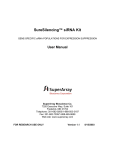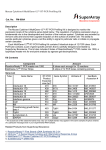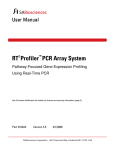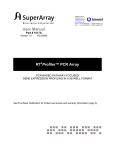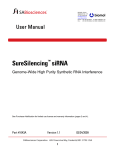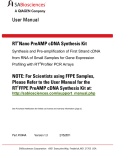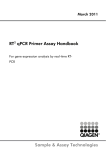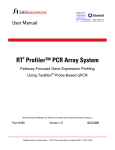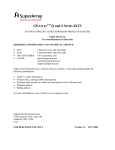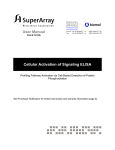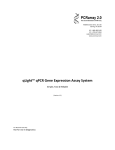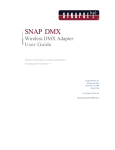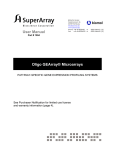Download User Manual RT Gene Expression Assays
Transcript
User Manual BIOMOL GmbH Waidmannstr. 35 22769 Hamburg [email protected] www.biomol.de Phone: +49-40-8532600 or Fax: +49-40-85326022 or 0800-2466651 (D) 0800-2466652 (D) Part # 1016A RT2 Gene Expression Assays REAL-TIME AND END-POINT RT-PCR VERIFICATION OF MICROARRAY DATA See Purchaser Notification for limited use license and warranty information (page 3). RT2 Gene Expression Assay User Manual Version 1.0 4/1/2005 2 RT2 Gene Expression Assays REAL-TIME AND END-POINT RT-PCR VERIFICATION OF MICROARRAY DATA USER MANUAL ORDERING INFORMATION AND TECHNICAL SERVICE • • • • TEL: FAX: ON-LINE ORDER: E-MAIL: 0800-2466651 (Germany); +49-40-8532600 0800-2466652 (Germany); +49-40-85326022 www.biomol.de [email protected] (to place an order) [email protected] (for technical support) You may place orders by phone, fax, e-mail or from our website. Each order should include the following information: • • • • • Your contact information (name, phone, email address) Product name, catalog number and quantity Purchase order number or credit card information (Visa or MasterCard) Shipping address Billing address For more information, visit us at http://www.biomol.de SuperArray Bioscience Corp. 7320 Executive Way, Suite 101 Frederick, MD 21704 USA 888.503.3187 301.682.9200 Technical Support [email protected] www.SuperArray.com RT2 Gene Expression Assay User Manual Version 1.0 4/1/2005 3 RT2 Real-Time™ Gene Expression Assay Kits TABLE OF CONTENTS I. Background and Introduction 4 II. Materials Provided 5 III. Additional Materials Required 5 IV. Complementary Products 5 V. Protocol A. Cell Lysis / RNA Isolation B. ReactionReady™ First Strand cDNA Synthesis C. RT2 Real-Time™ PCR Gene Expression Assay D. RT2 End-Point™ PCR Gene Expression Assay 6 7 8 10 VI. Troubleshooting and Frequently Asked Questions 12 Appendices: 1. Alternative First Strand cDNA Synthesis Protocol 2. Using Other SuperArray PCR Master Mixes 3. Relative Quantification using the ∆∆Ct Method 14 15 15 LIMITED PRODUCT WARRANTY This product is intended for research purposes only and is not intended for drug or diagnostic purposes or for human use. This warranty limits our liability to replace this product in the event the product fails to perform due to any manufacturing defect. SuperArray Bioscience Corporation makes no other warranties of any kind, expressed or implied, including without limitation, warranties of merchantability or fitness for a particular purpose. SuperArray Bioscience Corporation shall not be liable for any direct, indirect, consequential or incidental damages arising out of the use, the results of use or the inability to use this product. NOTICE TO PURCHASER 2 The purchase of RT Gene Expression Assays includes a limited, nonexclusive license to use the kit components for research use only. This license does not grant rights to use the kit components for reproduction of any primer pair mix, to 2 modify kit components for resale or to use RT Gene Expression Assays to manufacture commercial products without written approval of SuperArray Bioscience Corporation. No other license, expressed, implied or by estoppel, is granted. 2 U.S. patents may cover certain isolated DNA sequences included in the RT PCR Primer Sets. Presently, it is not clear under U.S. laws whether commercial users must obtain licenses from the owners of the rights to these U.S. patents before 2 using RT PCR Primer Sets. Technical Support 0800-2466651 +49-40-85326023 [email protected] www.biomol.de www.SuperArray.com RT2 Gene Expression Assay User Manual Version 1.0 4/1/2005 4 I. BACKGROUND AND INTRODUCTION The reverse transcription polymerase chain reaction (RT-PCR) is one of the most commonly used techniques for the verification of microarray data. However, researchers often face the challenge of minimizing or eliminating non-specific amplification (primer dimers or other gene products), because first strand cDNA contains thousands of genes each potentially available as a PCR template. Therefore, carefully designed PCR primers that specifically amplify the genes of interest are critical for successful PCR based analysis of gene expression. Taking advantage of an experimentally verified proprietary computer algorithm, SuperArray Bioscience has developed high quality gene-specific PCR primer sets and master mixes for convenient and genome-wide RTPCR microarray validation. The RT2 Real-Time™ and RT2 End-Point™ Gene Expression Assays are designed for using the SYBR® Green detection method for real-time PCR. We developed and tested our computer algorithm using an in vitro assay to ensure that the designed primer pairs generate a single PCR product of the predicted size and a minimal amount of primer dimer in 30 cycles of PCR amplification. As a result, the computer algorithm now specially designs the best primer pairs possible for SYBR® Green compatible real-time PCR detection. Primer sets are available for any human, mouse or rat gene. The assays also include a pre-formulated SYBR® Green compatible or conventional hot-start PCR master mix. Each of these instrument-specific master mixes contains an appropriate reference dye for a specific real-time system to match the instrumentation available in your laboratory. The specially formulated hot start enzyme outperforms other competing hot start enzymes by utilizing a longer activation step. Non-specific priming events are more effectively melted preventing the amplification of secondary products such as primer dimers. The master mixes are specifically optimized together with the primer sets to guarantee that these assays generate single amplicon products. To begin your microarray validation with the assays, first convert your experimental RNA samples into first strand cDNA, the template for the polymerase chain reaction using the ReactionReady™ First Strand cDNA Synthesis Kit (C-01). The complete RT2 Gene Expression Assays have been designed to be easy to use, economical, and accessible for routine use in every research laboratory. Benefits of the RT2 Gene Expression Assays for Microarray Validation: Genome-Wide Coverage: PCR Primer sets are available for every gene in the human, mouse and rat genome. Optimized Assay System: Assays include both optimized PCR primer set and PCR master mix. All assays have high amplification efficiencies and specificity. Flexibility and Ease of Use: Real-time PCR assays accommodate most real-time PCR systems. Conventional kits provide quantitative PCR to researchers without real-time PCR equipment. Technical Support 0800-2466651 +49-40-85326023 [email protected] www.biomol.de www.SuperArray.com RT2 Gene Expression Assay User Manual Version 1.0 4/1/2005 5 II. Materials Provided: RT2 PCR Primer Pair, one tube, either in 24- or 200-reaction scale Storage Conditions: Primer Sets are shipped at ambient temperature but must be stored at –20 °C where they are guaranteed as is for 6 months from the date received. III. Additional Materials Required: A. Qiagen RNeasy® Mini Kit (Cat. No. 74103) B. ReactionReady™ First Strand cDNA Synthesis Kit (Cat. No. C-01) Customers outside the USA without a local distributor, refer to materials listed for alternative protocol in the Appendix, page 10. C. RT2 PCR Master Mix to match with your instrumentation: RT2 Real-Time™ SYBR Green / ROX (Cat. No. PA-012) Specifically designed for ABI Instrumentation RT2 Real-Time™ SYBR Green / Fluorescein (Cat. No. PA-011) Specifically designed for BioRad iCylcer RT2 Real-Time™ SYBR Green (Cat. No. PA-010) Specifically designed for Cepheid SmartCycler and other instrumentation NOT requiring a reference dye ReactionReady™ HotStart “Sweet” (Cat. No. PA-007) Specifically designed for end-point (conventional) PCR D. ReactionReady™ Internal Normalizer for End-Point (Conventional) PCR ONLY Choose the correct one for your model species of interest. Human (PA-020-200), Mouse (PA-021-200), Rat (PA-022-200) E. 100-bp DNA Step Ladder (Promega Catalog # G695A) For End-Point (Conventional) PCR ONLY F. The following equipment will also be necessary to use this kit: a. For Real-Time PCR, thermal cycler capable of SYBR® Green I detection, such as ABI Instrumentation, BioRad iCylcer®, or Cepheid SmartCycler®. b. For End-Point PCR: i. Thermal Cycler: Any standard thermal cycler will suffice. ii. Agarose gel electrophoresis equipment and reagents iii. Gel Documentation Equipment IV. Complementary Products: A. XpressRef™ Universal Reference Total RNA Used as for calibration curve or as a positive control. Choose the correct one for your model species of interest. Human XpressRef™ Universal Reference Total RNA (Cat. No. GA-004) Mouse XpressRef™ Universal Reference Total RNA (Cat. No. GA-005) Rat XpressRef™ Universal Reference Total RNA (Cat. No. GA-006) Technical Support 0800-2466651 +49-40-85326023 [email protected] www.biomol.de www.SuperArray.com RT2 Gene Expression Assay User Manual Version 1.0 4/1/2005 6 V. Protocol: A. Cell Lysis / RNA Isolation One of the most important factors in successful RT-PCR analysis is the quality of the original RNA sample. RNA should be free of contaminating proteins, other cellular material, and particularly genomic DNA (see below) as well as phenol, ethanol, and salts used in the RNA isolation procedure. Impurities lower the efficiency of template synthesis and product amplification and detection. The RNA must also be intact and fulllength. Partially degraded RNA generates secondary amplicons shorter than the predicted size confounding the interpretation of expression profiling results. For total RNA isolation from cultured or freshly isolated animal cells, we recommend RNeasy Mini Kits from Qiagen (catalog number 74103). Be sure to include the DNase treatment step to minimize or eliminate genomic DNA contamination, which interferes with RT-PCR assays. (See below.) This kit isolates RNA of sufficient quantity and quality for the RT2 Real-Time™ and RT2 End-Point™ Gene Expression Assays from these biological sources. For total RNA isolation from animal tissues, we recommend homogenizing and then performing a phenol/chloroform extraction using the TRIzol® reagent from Invitrogen (Catalog Number 15596-026) prior to proceeding with the Qiagen RNeasy Mini Kit. Prepare the total RNA in RNase-Free H2O (DEPC-treated and autoclaved) at a concentration of at least 0.5 mg/ml for. Be sure to use the correct amount of RNA as described in the protocol below. NOTE: RNA Quality Control Always check the quality of the RNA preparation before continuing this protocol. The A260:A280 and A260:A230 ratios of the total RNA preparation should be at least 1.8. Characterization of total RNA samples by denaturing agarose gel electrophoresis or Agilent 2100 BioAnalyzer should yield sharp (not smeared) 28S and 18S ribosomal RNA (rRNA) bands having an intensity ratio of roughly 2:1. Any deviation from these specifications indicates degradation of the RNA sample. In which case, isolate fresh RNA before proceeding with this protocol. NOTE: Genomic DNA Contamination: See also: Troubleshooting and Frequently Asked Questions Minimizing or eliminating genomic DNA contamination is essential for obtaining optimal microarray validation results using the RT2 Gene Expression Assays. Contamination can be detected by performing a control assay replacing the reverse transcriptase (RE) with water (H2O). (See below.) If the difference in real-time Ct values between the water control and other samples in less than 6, then the apparent genomic contamination will affect the relative gene expression profiling result. If genomic DNA contamination is apparent, include any DNase treatment steps recommended by your RNA isolation procedure or treat RNA separately with RNase-free DNase followed by re-purification using a spin-column based method. Technical Support 0800-2466651 +49-40-85326023 [email protected] www.biomol.de www.SuperArray.com RT2 Gene Expression Assay User Manual Version 1.0 4/1/2005 7 B. ReactionReady™ First Strand cDNA Synthesis (C-01) Perform one reaction for each experimental RNA sample and one for a source of universal reference RNA, for example, XpressRef™ Universal Reference Total RNA (see Complementary Products). NOTE: To control for genomic DNA contamination, also perform an extra “Minus-RT” reaction control for each RNA sample simply by replacing the RE component (Reverse Transcriptase) with RNase-free H2O. NOTE: An alternative first strand cDNA synthesis protocol using components for other manufacturers is provided in the Appendix 1, particularly for customers without a local distributor of SuperArray products. 1. Prepare the Annealing Mixture: For each RNA sample, combine the following in a sterile PCR tube: Total RNA 1.0 to 5.0 Buffer P 1.0 RNase-free H2O to a final volume of 10.0 µg µl µl Mix the contents gently with a pipettor followed by brief centrifugation. Place the mixture in a thermal cycler at 70 °C for 3 min. Cool to 37 °C and incubate there for 10 min. 2. Prepare the RT Cocktail: This mixture can be prepared while the Annealing Mixture is incubating at 37 °C. RT Cocktail Buffer BC (5X RT Buffer) RNase-free H2O RI (RNase Inhibitor) RE (Reverse Transcriptase) Final Volume 1 reaction 4 µl 4 µl 1 µl 1 µl 10 µl 2 reactions 4 reactions 8 reactions 8 µl 16 µl 32 µl 8 µl 16 µl 32 µl 2 µl 4 µl 8 µl 2 µl 4 µl 8 µl 20 µl 40 µl 80 µl Warm the RT Cocktail at 37 °C for 1 min before proceeding to the next step. 3. First Strand cDNA Synthesis Reaction: Add 10 µl of RT Cocktail to each 10 µl-Annealing Mixture. Mix well but gently with a pipettor and continue incubation at 37 °C for 60 min. Heat at 95 °C for 5 min to degrade the RNA and to inactivate the reverse transcriptase. Hold the finished First Strand cDNA Synthesis Reaction on ice until the next step. Technical Support 0800-2466651 +49-40-85326023 [email protected] www.biomol.de www.SuperArray.com RT2 Gene Expression Assay User Manual Version 1.0 4/1/2005 8 3. RT2 Real-Time™ Gene Expression Assay Polymerase Chain Reaction (PCR): a. Setup: i. Standard Curve: Prepare five (5) ten-fold serial dilutions in duplicate of a template known to express the gene of interest. For example, when comparing the expression of a gene between two samples, use template from control RNA for a down-regulated gene or from experimental RNA for an up-regulated gene. For multiple samples and / or multiple genes with more complex expression patterns, use a mixture of equal amounts of each template or the template generated from the Universal Reference RNA. Each dilution will be used in a separate reaction. ii. Positive and Negative Controls: Prepare the positive control as a reaction with template known to express the gene of interest such as template from Universal Reference RNA (if not already used for the standard curve) or full-length cDNA clone (if available). Or use template prepared from an in vitro transcript of the gene of interest (if available). If your standard curve already includes template from a universal source of reference RNA, the extra positive control is not necessary. Prepare the negative control as a reaction which replaces template with water (or the so-called water control). iii. Sample Replicates: Prepare two ten-fold serial dilutions in triplicate (3) of each template generated from an experimental RNA sample. iv. Prepare replicate sets of all reactions: Prepare one set for each gene of interest and one set for an appropriate housekeeping gene. Choose a housekeeping gene known to not change its expression under your experimental conditions, such as the one used to normalize your microarray results. b. Polymerase Chain Reactions: For each 25-µl PCR, mix the following components in a PCR tube: 12.5 µl RT2 Real-Time™ PCR master mix, matched with your instrument 1.0 µl of a diluted first strand cDNA synthesis reaction 1.0 µl RT2 PCR Primer Set™ 2.5 µl 10X Reference Dye Stock Solution (if needed)* . Bring to final volume of 25 µl using ddH2O. Final concentrations of master mix components in PCR: Active ingredients: 10 mM Tris-Cl, 50 mM KCl, 2.0 mM MgCl2, 0.2 mM dNTPs, HotStart Taq DNA polymerase. Inert ingredients: Stabilizer. Final primer concentration: 0.2 µM. * If SuperArray does not currently offer a RT2 Real-Time™ PCR master mix for your instrument, use the RT2 Real-Time™ SYBR Green PCR master mix (PA-010) and identify the appropriate reference dye from the instrument’s manufacturer and prepare a 10X stock. Technical Support 0800-2466651 +49-40-85326023 [email protected] www.biomol.de www.SuperArray.com RT2 Gene Expression Assay User Manual Version 1.0 4/1/2005 9 Place tubes in real-time thermal cycler. Enter the following program: 95 °C, 15 min; 40 cycles (95 °C, 30 sec; 55 °C, 30 sec; and 72 °C, 30 sec); 72 °C, 5 min o o 95 C 95 C 15 min 30 sec o o 55 C 30 sec o 72 C 72 C 30 sec 5 min o 4C … 40 cycles* * The PCR cycle number should be optimized for each experiment. Try using 40 cycles at first. Use more only if necessary. The 15 min step at 95 °C is required to activate the HotStart Taq DNA polymerase. Program the real-time thermal cycler to detect and record the SYBR® Green I signal from every reaction. Record the fluorescence reading during the annealing and extension steps of each cycle. Calculate the threshold cycle (Ct) for the specific gene in each reaction using the instrument’s software. c. Quality Control: i. Melting (Dissociation) Curve: Run the following program immediately after the above program: 95 °C, 1 min; 65 °C, 2 min (OPTICS OFF); 65 °C to 95 C at 2 °C / sec (OPTICS ON) Generate a first derivative dissociation curve. Only one peak should appear at temperatures greater than 80 °C. ii. Agarose gel electrophoresis: Save reactions for agarose gel characterization as described for End-Point assay for troubleshooting purposes after adding gel loading dye. Only one band should be apparent in each lane. d. Real-Time Data Analysis: Standard Curves Method Using instrument’s software, determine Ct value for each reaction. Plot Ct of standard curve versus the log (base 10) of the dilution factor used for each reaction for all genes (different plot for each). Fit the data to straight lines. Using the appropriate Ct values and the standard curve, determine the relative amount of each gene in each sample. Normalize the expression level of each gene of interest to the expression level of the housekeeping gene in each sample. To calculate fold-changes in gene expression, divide the normalized expression levels for each gene of interest in each experimental sample by normalized expression levels of the same gene in the appropriate control sample. Technical Support 0800-2466651 +49-40-85326023 [email protected] www.biomol.de www.SuperArray.com RT2 Gene Expression Assay User Manual Version 1.0 4/1/2005 10 4. RT2 End-Point™ Gene Expression Assay Polymerase Chain Reaction (PCR): a. Setup: Prepare two to three ten-fold serial dilutions of each template and perform a reaction for each one to insure that at least one of them lies in the linear dynamic range of agarose gel-based detection. Too much template causes of the band intensity for the gene of interest to saturate and interferes with the detection of the Internal Normalizer. Too little template prevent detection of the gene of interest. b. Polymerase Chain Reactions: For each 25-µl PCR, mix the following components in a PCR tube: 12.5 µl ReactionReady™ HotStart Sweet PCR maser mix (PA-007) 9.5 µl ddH20 1.0 µl of the completed first strand cDNA synthesis reaction 1.0 µl GAPD Internal Normalizer Primer Mix for appropriate species 1.0 µl RT2 PCR Primer Set_________________________________ 25 µl final volume Final concentrations of master mix components in PCR: Active ingredients: 10 mM Tris-Cl, 50 mM KCl, 1.5 mM MgCl2, 0.2 mM dNTPs, Taq DNA polymerase. Inert ingredients: Bulking Agent (for lyophilization and gel loading), Dye (for gel loading). Final primer concentration: 0.2 µM. c. Place tubes in thermal cycler. Enter and run the following program: 95 °C, 15 min; 30 cycles (95 °C, 30 sec; 55 °C, 30 sec; and 72 °C, 30 sec); 72 °C, 5 min o o 95 C 95 C 15 min 30 sec o o 55 C 30 sec o 72 C 72 C 30 sec 5 min o 40 cycles* 4C … * The PCR cycle number should be optimized for each experiment. We recommend starting with 30 cycles for your first reaction. The 15 min step at 95 °C is required to activate the HotStart Taq DNA polymerase. d. Product Characterization: i. When the PCR is complete, load 10 µl of each reaction into separate wells of a 2% agarose gel containing 0.5 µg/ml ethidium bromide in 1X TAE. NOTE: No gel loading dye or buffer is required. The ReactionReady™ HotStart “Sweet” PCR master mix already contains gel-loading dye. ii. Load an appropriate amount of 100-bp DNA Step Ladder (Promega G695A) in an adjacent lane. iii. Electrophorese in 1X TAE at 90V for 40 minutes or before the orange tracking dye (at <10 base pairs) runs off the gel. iv. Capture an image of the gel with a UV Trans Illuminator using a CCD camera or high-speed film. Technical Support 0800-2466651 +49-40-85326023 [email protected] www.biomol.de www.SuperArray.com RT2 Gene Expression Assay User Manual Version 1.0 4/1/2005 11 e. Image Acquisition and Data Acquisition and Analysis: Individual product information sheets list expected sizes of RT2 End-Point™ PCR products. Check the size of your RT2 End-Point™ target against the size of the Internal Normalizer. i. Image Acquisition: At this time, we highly recommend using a CCD camera to capture the image of the gel because the Data Acquisition will be more straightforward and the resulting data will have a wider dynamic range. A high-speed photograph can be used; however, the image must be digitized by other means, separate software must be used, and the dynamic range will be smaller. ii. Data Acquisition If a CCD camera was used to capture the image of the gel, the software accompanying the instrument should be able to convert the image of the bands into data. Follow the instructions for that software. If relying on a high-speed photograph of the gel, digitize the image of the gel using a desktop scanner to obtain a TIFF file of the image. To convert that image into data, we then recommend using the software “NIH IMAGE” (Available free from the NIH. See the following web page and its links for more information: http://rsb.info.nih.gov/nih-image/). Follow the instructions for that software. iii. Data Analysis During Data Acquisition, remember to use the software to determine an appropriate background value. That is, use the same rectangle or other shape used to surround the gel bands to surround a blank area of the gel and obtain data from that area. Subtract that background value from the integrated intensity values of all other data points obtained from the gel bands. Finally, divide each of the background-corrected values by the background-corrected value for the GAPD Internal Normalizer band intensity. These background-corrected and normalized values can then be compared between experimental conditions. For example, fold changes in gene expression can be calculated. Technical Support 0800-2466651 +49-40-85326023 [email protected] www.biomol.de www.SuperArray.com RT2 Gene Expression Assay User Manual Version 1.0 4/1/2005 12 VI. TROUBLESHOOTING GUIDE AND FREQUENTLY ASKED QUESTIONS: A. Appearance of Multiple Products: Multiple real-time first-derivative dissociation peaks verified by agarose gel or multiple end-point bands by agarose gel electrophoresis 1. Bands much larger in size or even close to the size of the predicted amplicon: Contamination of the RNA with genomic DNA: Verify contamination by observing a product (and/or Ct value) from a “minus RT” control, a RT-PCR assay containing a portion or dilution of a mock reverse transcription reaction lacking the critical enzyme. Include any DNase treatment steps recommended by your RNA isolation procedure or treat RNA separately with RNase-free DNase followed by re-purification using a spincolumn based method (e.g., Qiagen RNeasy Mini Kit). 2. Bands slightly smaller or larger than the size of the predicted amplicon: Presence of undiscovered alternative transcripts: Roughly 45 percent of all human genes are predicted to have alternative transcripts, yet variants for only 9 percent of human genes have been annotated by the NCBI. RT2 PCR Primers Sets for genes with known variants amplify sequence common to all transcripts and detect the sum of their expression. Primer design cannot account for genes with un-annotated transcripts. 3. Primer Dimers: a. Verify presence of primer dimers (< 50 bp in size) by agarose gel. b. If you are not doing so already, try to use the appropriate RT2 PCR Master Mix from SuperArray to prevent the appearance of primer dimers. c. Otherwise, call a Technical Support representative. B. Water (no template) control yields a real-time Ct value < 35 cycles or an endpoint detectable product by agarose gel: 1. DNA contamination of other reagents, tips, and tubes: Use only PCR-grade reagents and lab ware. Wear gloves throughout the procedure. Do not leave lab ware (open tubes and tip boxes) exposed for long periods of time. Some researchers expose lab ware with UV light to render any contaminating DNA ineffective in PCR through the formation of thymidine dimers. 2. Primer Dimers: a. Verify presence of primer dimers (< 50 bp in size) by agarose gel. b. If you are not doing so already, try to use the appropriate RT2 PCR Master Mix from SuperArray to prevent the appearance of primer dimers. c. Otherwise, call a Technical Support representative. Technical Support 0800-2466651 +49-40-85326023 [email protected] www.biomol.de www.SuperArray.com RT2 Gene Expression Assay User Manual Version 1.0 4/1/2005 13 C. Unknown or standard curve reactions yield low real-time Ct values (< 12) or, in end-point assays, a saturated band intensity for the gene of interest and/or a weak Internal Normalizer band intensity: Too much template cDNA: 1. Use less input RNA for reverse transcription if at the higher end of range. 2. Use cDNA template samples at a higher dilution (lower concentration). 3. However, do not use less than 1 µl of dilute cDNA per each 25-µl reaction. D. Unknown or standard curve reactions yield real-time high Ct values (> 35) (or none at all), or, in end-point assays, no gene of interest band is detectable: 1. Poor RNA quality: Be sure to perform all recommended quality control checks. 2. Not enough template cDNA: a. Use more input RNA for reverse transcription especially if using the lower end of the recommended range. b. Use cDNA template samples at a lower dilution (higher concentration). c. Use a larger volume of cDNA per reaction, but do not use more than 2.5 µl of dilute cDNA per each 25-µl reaction. Remember to use the same amount of cDNA volume in each reaction. E. Real-time unknown or standard curve reactions yield Ct values close to the water / no template control (∆Ct < 6): Water control Ct value is too low or sample Ct values are too high. See the appropriate troubleshooting question and answers. If the difference in Ct values between the water control and other samples in greater than 6, then the apparent presence of secondary products will not affect the relative gene expression profiling result. F. No apparent difference in target gene band intensity and very faint or nonexistent GAPD Internal Normalizer band: Too much template cDNA: 1. Use less input RNA for reverse transcription if at the higher end of range 2. Use cDNA template samples at a higher dilution (lower concentration). 3. However, do not use less than 1 µl of dilute cDNA per each 25-µl reaction. If you have additional questions, please check our website (www.superarray.com) for a more complete listing of Frequently Asked Questions (FAQs), or call our Technical Support Representatives at 1-888-503-3187 or 301-682-9200. RNeasy® is a registered trademark of Qiagen. SYBR® is a registered trademark of Molecular Probes. iCycler® is a registered trademark of BioRad Laboratories, Inc. SmartCycler® is a registered trademark of Cepheid Technical Support 0800-2466651 +49-40-85326023 [email protected] www.biomol.de www.SuperArray.com RT2 Gene Expression Assay User Manual Version 1.0 4/1/2005 14 Appendix 1: Alternative First Strand cDNA Synthesis Protocol The following protocol describes the use of individual components from another manufacturer to synthesize first strand cDNA. Customers outside the USA without a local distributor should buy these individual components for first strand cDNA synthesis and follow this protocol. Additional Materials Required: Individual components for first strand cDNA synthesis may be purchased separately from another manufacturer: Reagent Random Primers RNase Inhibitor Reverse Transcriptase dNTPs Product Promega Catalog # C1181 Promega Catalog # N2511 Promega Catalog # M1701 Promega Catalog # U1330 Kit component Buffer P Component RI Component RE 1. Prepare the Annealing Mixture: For each total RNA sample, combine the following into a sterile PCR tube: Total RNA 1.0 to 5.0 Random Primers 1.0 RNase-free H2O to a final volume of 10.0 µg µl µl Mix the contents gently with a pipettor followed by brief centrifugation. Place the mixture in a thermal cycler at 70 °C for 3 min. Cool to 37 °C and keep at that temperature for 10 min. 2. Prepare the RT Cocktail: This mixture can be prepared while the Annealing Mixture is incubating at 37 °C. RT Cocktail 5X Promega Reaction Buffer 2.5 mM dNTP Mix* RNase Inhibitor MMLV Reverse Transcriptase Final Volume 1 reaction 4 µl 4 µl 1 µl 1 µl 10 µl 2 reactions 8 µl 8 µl 2 µl 2 µl 20 µl 4 reactions 8 reactions 16 µl 32 µl 16 µl 32 µl 4 µl 8 µl 4 µl 8 µl 40 µl 80 µl * Dilute 100 mM stock 1:40 with RNase-free H2O first. Warm the RT Cocktail at 37 °C for 1 min before proceeding to the next step. 3. First Strand cDNA Synthesis Reaction: Add 10 µl of RT Cocktail to each 10 µl-Annealing Mixture. Mix well but gently with a pipettor and continue incubation at 37 °C for 60 min. Heat at 95 °C for 5 min to degrade the RNA and to inactivate the reverse transcriptase. Hold the finished First Strand cDNA Synthesis Reaction on ice until the next step. Technical Support 0800-2466651 +49-40-85326023 [email protected] www.biomol.de www.SuperArray.com RT2 Gene Expression Assay User Manual Version 1.0 4/1/2005 15 Appendix 2: Using Other SuperArray PCR Master Mixes For real-time PCR master mixes (catalog numbers PA-008 and PA-009), prepare stock solutions of SYBR® Green I. SYBR® Green I is shipped by Molecular Probes as a 10,000X concentrate in DMSO. Upon receiving, generate a 100X Stock: Mix 1 µl SYBR® Green I 10,000X concentrate with 100 µl DMSO. Aliquot and store at –20 °C. On the day of the experiment, generate a 5X SYBR® Green I Solution: Mix 5 µl of the 100X SYBR® Green I Stock with 95 µl ddH2O. Store on ice. Use only on the same day. Discard any remainder. IMPORTANT: PROTECT SYBR® Green I SOLUTIONS FROM LIGHT. For PA-009, add 2.5 µl of 5X SYBR® Green to each 25-µl reaction. For the lyophilized real-time PCR master mix (PA-008), generate a 2X PCR cocktail. Add 120 µl of ddH2O and 30 µl of 5X SYBR® Green to one tube of master mix. For the lyophilized end-point PCR master mix (PA-006), generate a 2X PCR cocktail by adding 150 µl of ddH2O to one tube of master mix. Allow the lyophilized components to dissolve by letting the tube sit for a few minutes or by brief and gentle vortexing. Add 12.5 µl of 2X cocktail to each 25-µl reaction. Any unused portion of the re-suspended master mix can be stored at –20 °C, but must be used within two weeks. Appendix 3: Relative Quantification using the ∆∆Ct Method Note: Use this method for more high-throughput applications only if you have previously determined that the replication efficiencies (slopes of the calibration curves) for your gene of interest and housekeeping gene are the same. 1. In separate reactions, determine the Ct for a housekeeping gene and for the all genes of interest for each sample. Be sure that the values would have fallen on the respective standard curves. 2. For each sample, calculate the difference between the Ct value for the gene of interest and the housekeeping gene. ∆Ct (sample) = Ct (target gene) – Ct (housekeeping gene) 3. For each set of samples to be compared, calculate the difference in ∆Ct values. ∆∆Ct = ∆Ct (experimental sample) - ∆Ct (control sample) 4. Calculate fold-change in gene expression: If the slopes of the calibration curve are near -3.3 (100 percent amplification efficiency), then the fold-change in gene expression = 2∆∆Ct. If the slopes of the calibration curve are greater than -3.3 (less than 100 percent amplification efficiency), then the fold-change in gene expression = 10∆∆Ct/m, where m is equal to the average of the slopes. Technical Support 0800-2466651 +49-40-85326023 [email protected] www.biomol.de www.SuperArray.com RT2 Gene Expression Assay User Manual Version 1.0 4/1/2005 16 RT2 Gene Expression Assays Real-Time and End-Point RT-PCR Verification of Microarray Data BIOMOL GmbH Waidmannstr. 35 22769 Hamburg [email protected] www.biomol.de Phone: +49-40-8532600 or Fax: +49-40-85326022 or 0800-2466651 (D) 0800-2466652 (D) Technical Support 0800-2466651 +49-40-85326023 [email protected] www.biomol.de www.SuperArray.com
















